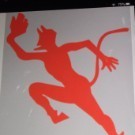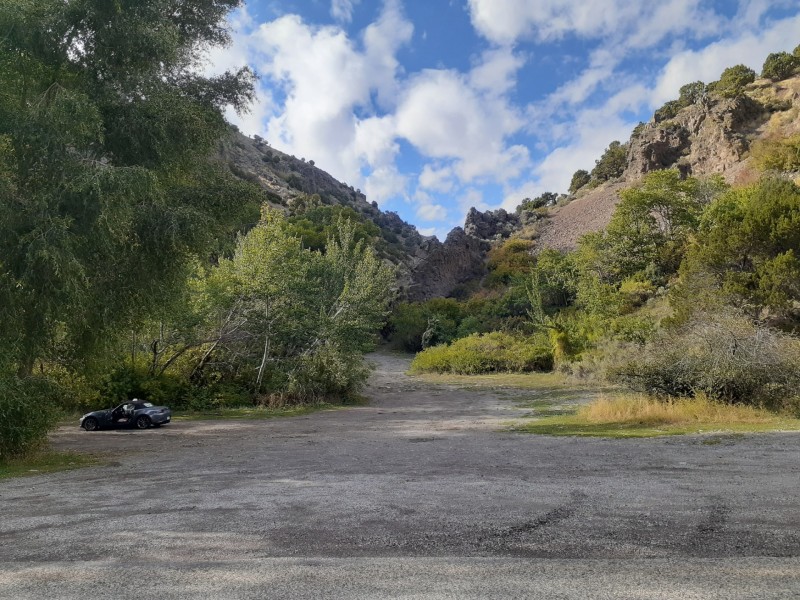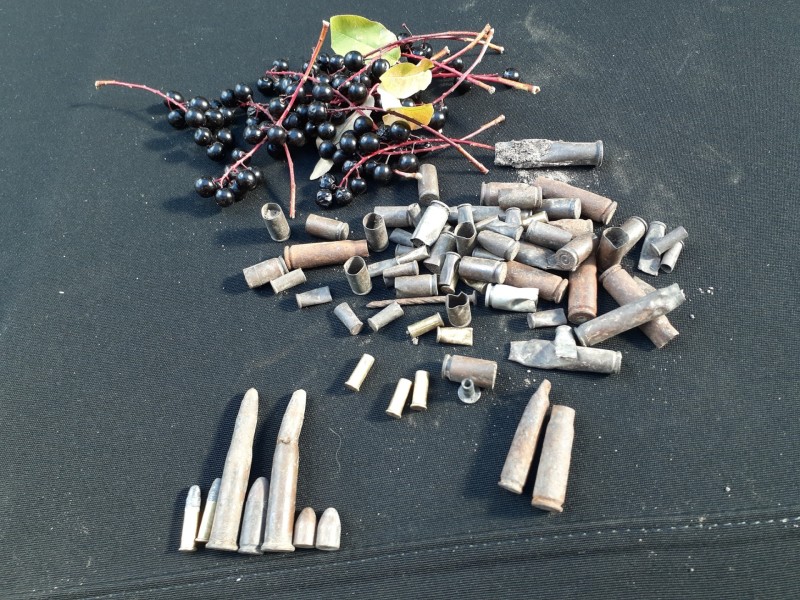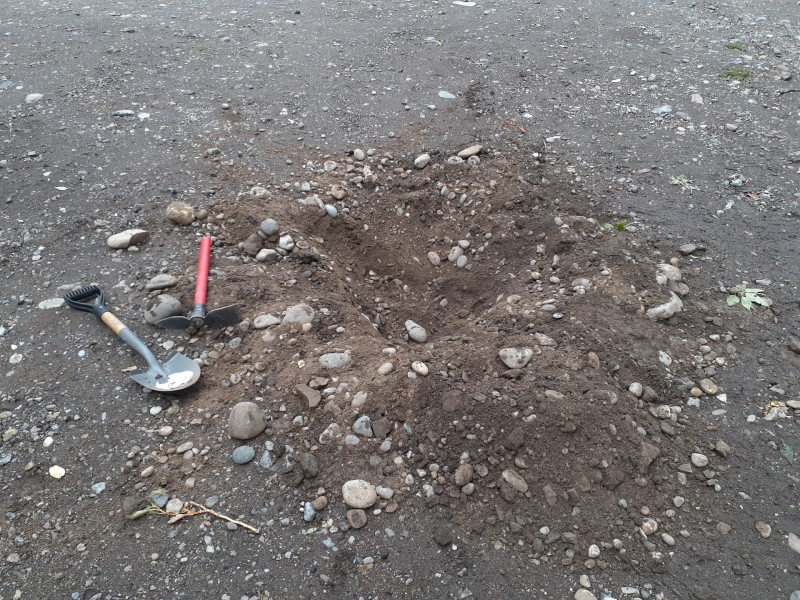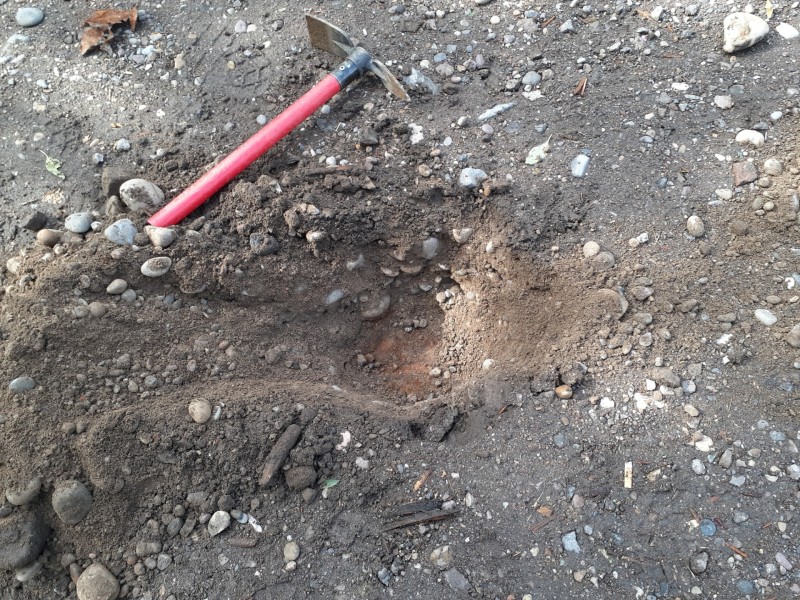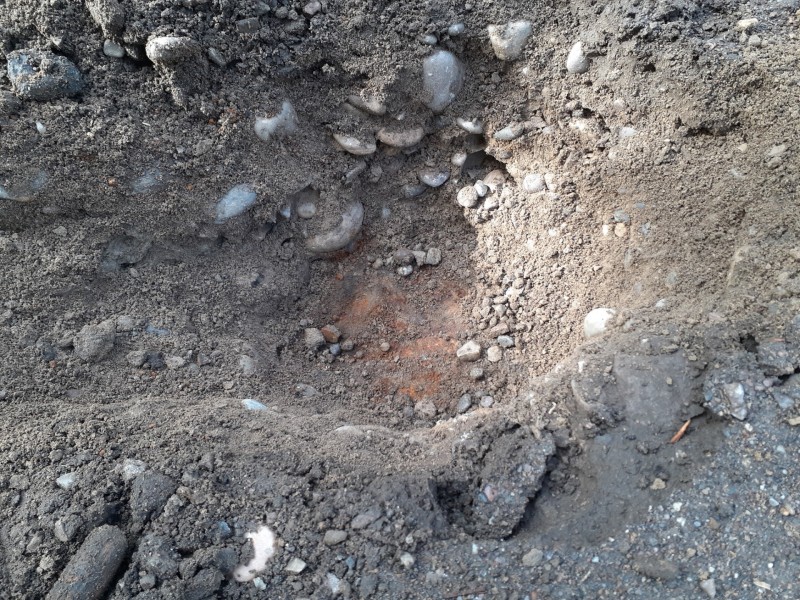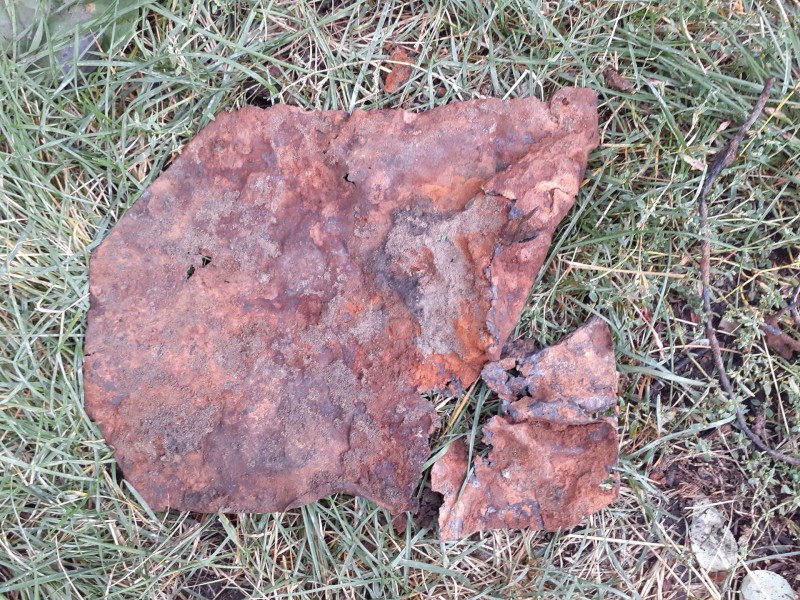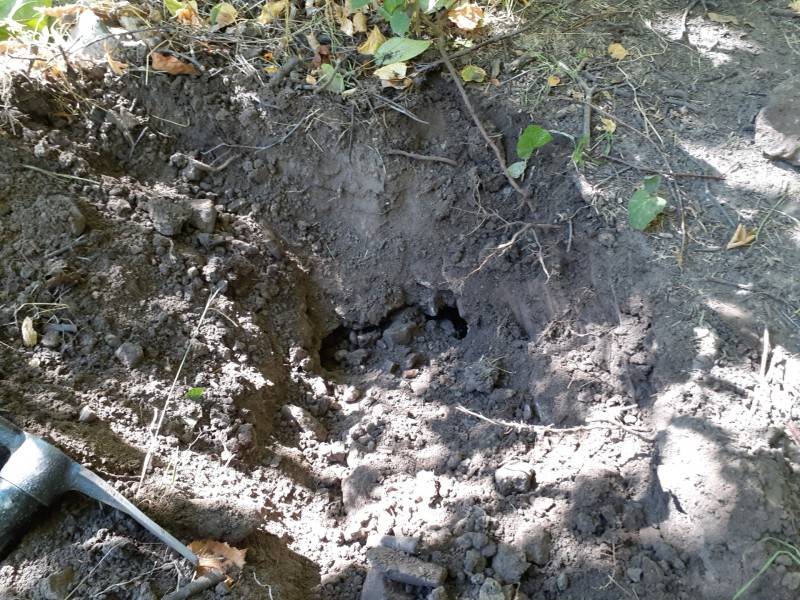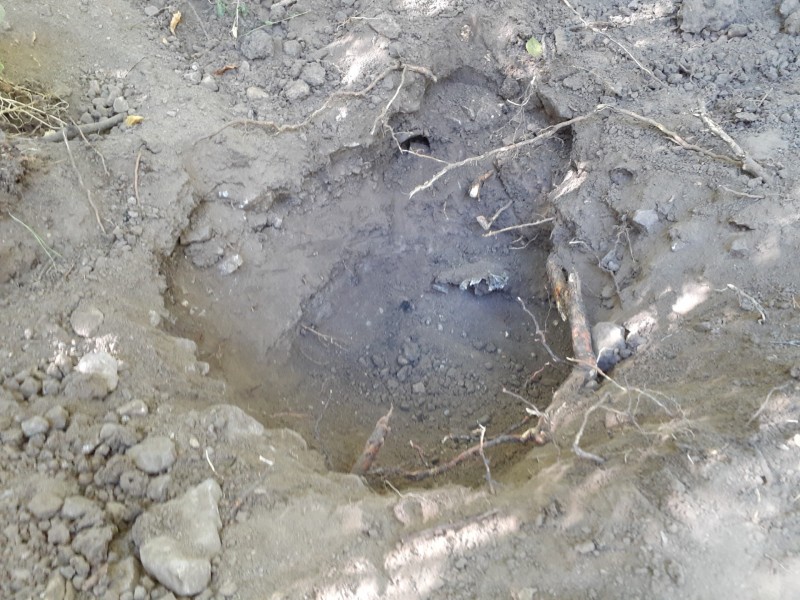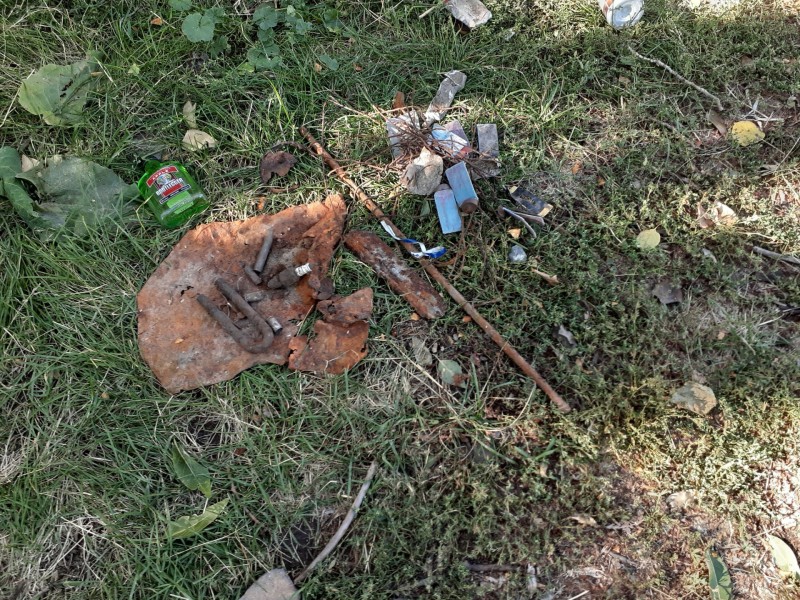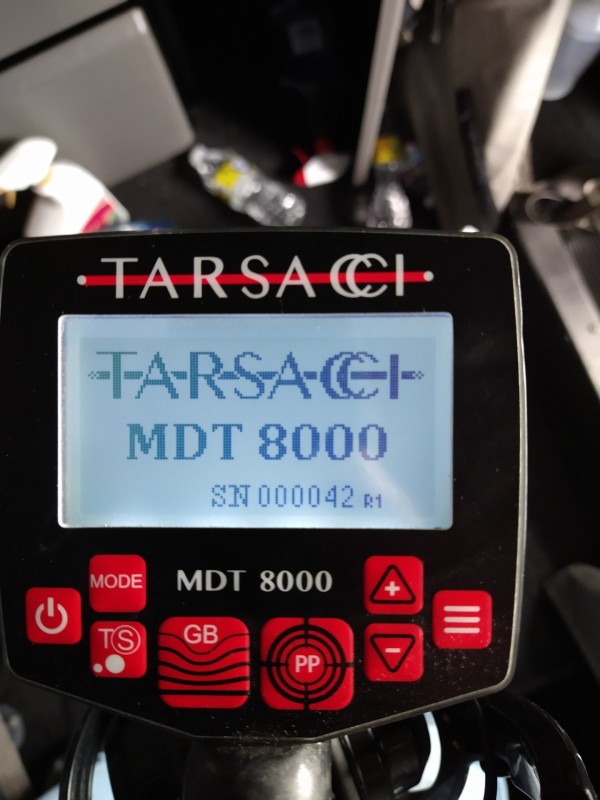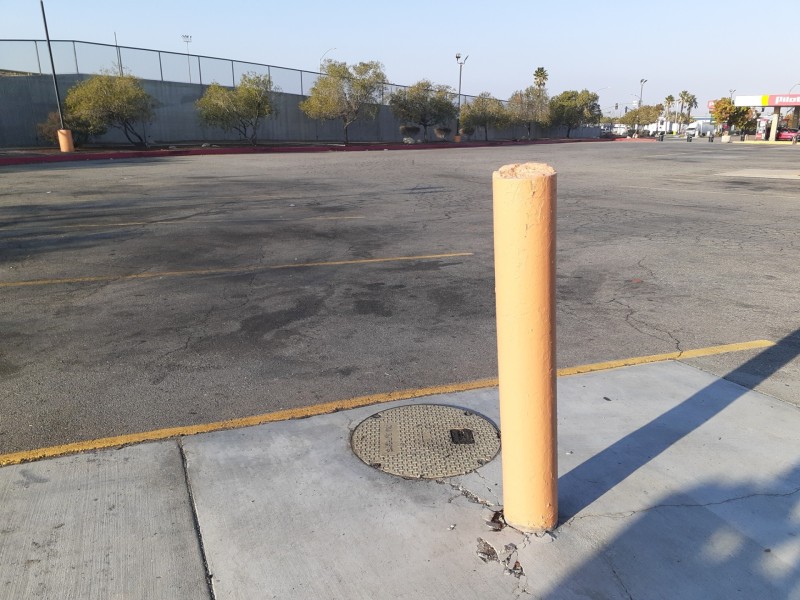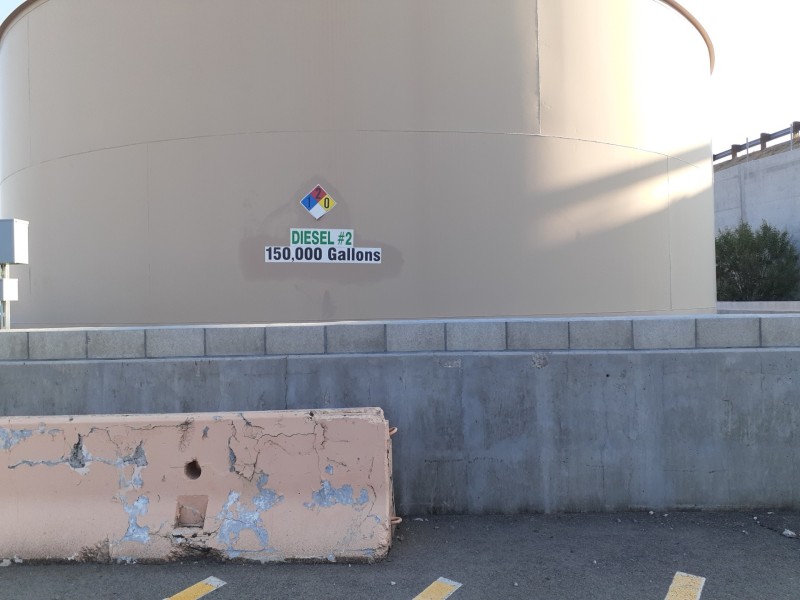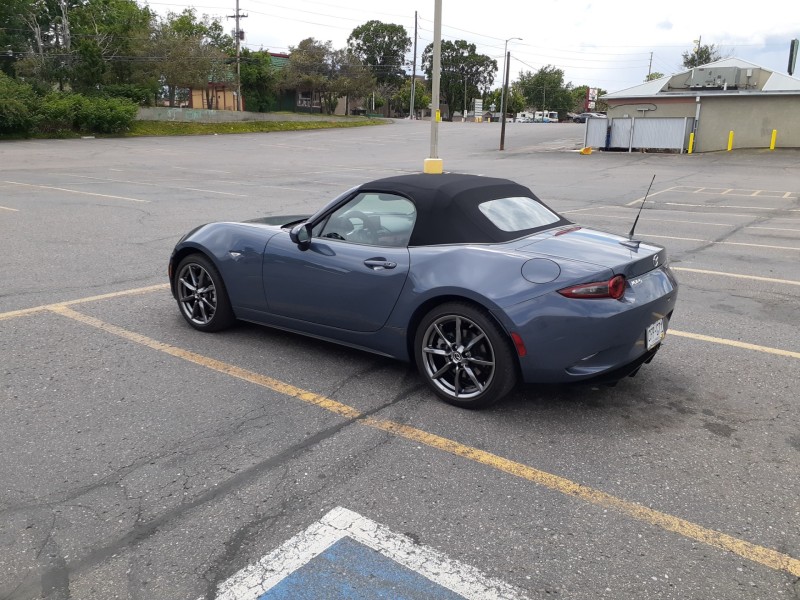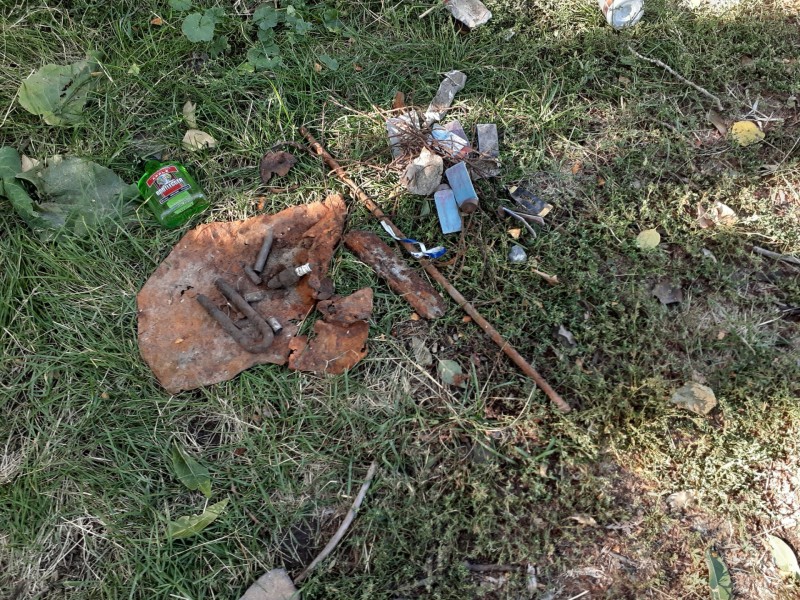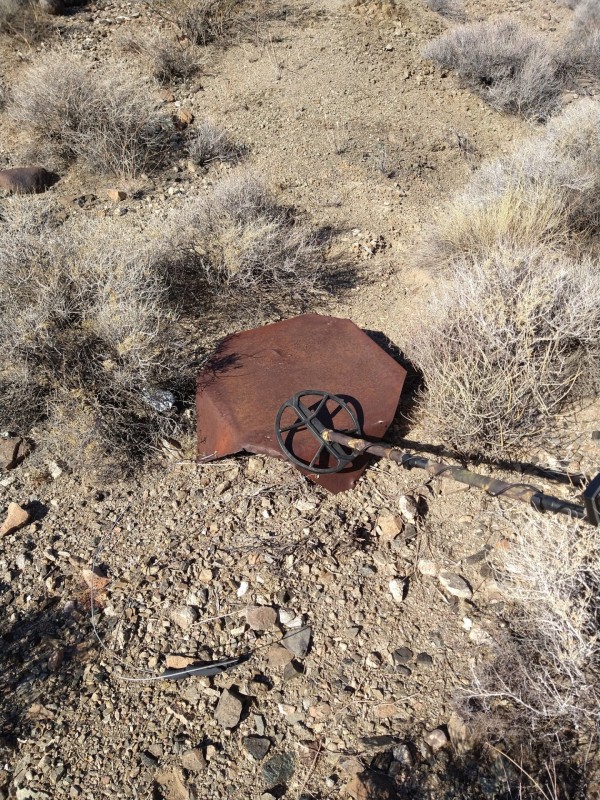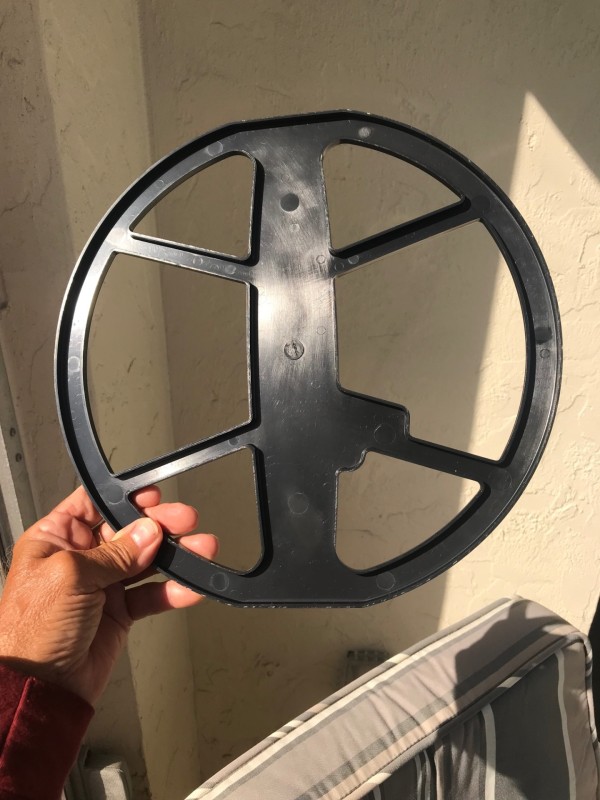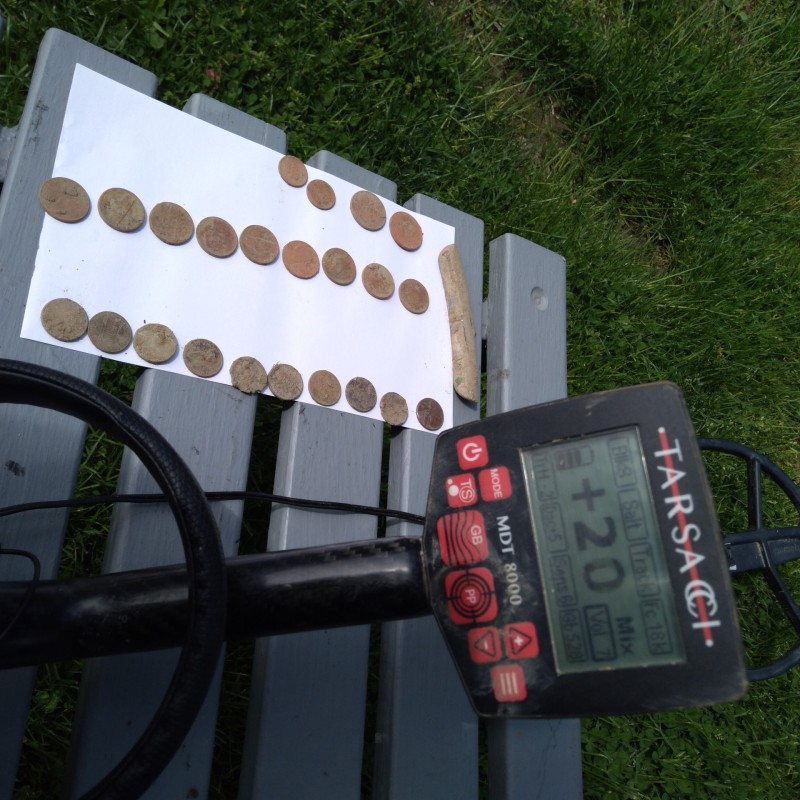Search the Community
Showing results for tags 'tarsacci'.
-
I’m thinking about getting another Tarsacci and I’m wondering has the Tarsacci had any updates what’s so ever? I’m hoping maybe some improvement on the volume when in discrimination mode? How about a smaller coil are is that ever too be ?I think I should have said never to be on the coil. Surely something has changed ? I haven’t checked the price just maybe it’s lower! I’ve seen more activity in a funeral home than on the Tarsacci forum. Lay it on me guys in what’s new on the Tarsacci. Chuck
-
After five months of testing with Tarsacci on the same site, I can say that this detector performs better in an environment full of iron and ceramics compared to DEUS II and The Legend Nokta Makro. Requires more time to learn and the audio is slightly less describing the objects in the ground. On the one hand, it is not distracting, on the other hand, it causes questions. Iron does not mask as much as in SMF devices. Similarly, the temperature above 30 degrees C The Legend and Deus II lose performance and stability after 15 - 20 minutes, the Tarsacci is doing much better. Maybe it's a performance issue or maybe it's a hybrid technology. I do not know. Target signaling comfort is better in The Legend and D2. In Tarsacci, the object must in DISC mode produce a fast repetitive ding-dong signal. A small copper coin 10mm in diameter by 25cm from a very irony spot is not a problem. Sand soil. Ergonomy is slight better with D2 and The Legend.
- 2 replies
-
- 5
-

-
- tarsacci
- nokta legend
-
(and 1 more)
Tagged with:
-
I’ve seen more activity in a funeral home than what I see here. This is what happens when even the company don’t show interest in what people have to say and don’t respond to questions ask bye email. Sad to say something good could be something great in given time. Chuck
-
I had been viewing something other than the Tarsacci and was trying to make my way back to the forum when up pops I believe every video made on the Tarsacci. It’s so hard believe after all this time not one word of anything new about the Tarsacci. What I seen the last video was made in October 22 on the Tarsacci. I would think a dealer out there should know something but if not be asking the man in the know. I sure didn’t get anything out of him . I got a thank you for being a customer but not one word about just maybe coming out with a small coil. Detector Stuff I know you’re not a dealer for the Tarsacci but you had planned a interview with that company . Do you see yourself doing that anytime soon? I don’t see myself buying back into the same I had but I wish I’d keep it. That’s more I can say for all the other detectors I’ve own. The Tarsacci had be the best built detector I’ve owned but’s just in need of some updates. Only time will tell where the Tarsacci will be in a year from now. I truly hope not in a dead file somewhere. Chuck
-
Hello everyone, I'm working on an interview/Q&A session with Dimitar Gargov for my site www.detectorstuff.com. Dimitar agreed to allow me to reach out to this forum and NASA Tom's to see if any of you folks may have a question or two. I'll try to include as many as possible! I also want to thank Steve H. for letting me ask here!
-
-
Broken original post - content moved to first post in this thread.
-
I am spending a week at the beach waiting for the tide to go down. I will post the finds later. While reading the other posts about what is the best detector, I realized why the Tarsacci is the beach machine for me. 1. In mixed mode it gives a very clear dig or don't dig signal. Since I am a simple person, this is all I need. It doesn't matter if it's a penny or a gold ring, if the Tarsacci tells me to dig, I dig. 2. It will reach down 16 inches. In the surf, where the holes are filling in as quickly as I can dig them, I really don't need anything much deeper. Could I use it in the wet sand? Maybe, but how much deeper are the new machines? A half an inch? 3 It is built like a tank. I am pretty rough on my equipment and the Tarsacci has never failed me. 4. It pinpoints spot on when you find a target. The thing I hated about the Nox was the pinpoint function was poor and I would lose targets in the wet sand when they sunk out of sight because I was digging in the wrong place and the hole was filling in. Depth, Accuracy and Rugged. My only complaint is I would like it to be a little lighter, but Dimitar can do that with the next Tarsacci. Some people want accurate vdi numbers and pretty tones. I just want the machine to tell me when and where to dig.
-
Here is part 2 from the original interview Keith and I did w Dimitar. Part 1 Here Aaron. In part 1, we discussed how Dimatar got into metal detecting and designing detectors, his origins with Fisher, and the Tarsacci’s Salinity and Ground Balance features. In part 2, we talk more about the Tarsacci’s unique MDT technology. However as you’ll see, just like any other inventor, Dimitar is very cautious when discussing his “intellectual property”, and is one hard “egg” to crack! Aaron - Okay, so how about we talk a little about the “roots of the technology” of Tarsacci? Dimatar - Well, the “roots of the technology” is a on going problem and not related to Fisher or any other companies cause, its different. And this is why it is in Patent Pending, the patents are applied, and I’m just waiting when their released. The patents are applied here in the US and in Europe. Aaron - You’ve applied for International Patents? Man,,that’s EXPENSIVE! Dimatar - But, I have too! Because if you don’t do that, and you don’t invest in that direction, sure were talking about high expenses, but this also has to be added into the unit cost. Keith - Yes! Dimatar- And somehow, I need to get a reimbursement for my investment. But, it’s a hobby and I enjoy it and when this will happen, I do not know....Ha! But, I’m enjoying detecting, I enjoy designing metal detectors, I enjoy solving this challenges. Aaron - It’s very unique to find a metal detecting engineer who ALSO enjoys detecting, you know? Keith - Yes that’s rare, that’s REALLY rare! Dimatar - And...I’m LISTENING to the community! I detect for myself and every one of us has a different style, EVERYONE. Theres no universal recipe, you can give guidance, but to give magic settings to cover every place, such a thing does not exist. This is why I always advise the customers, you have initial settings which will help you to start. Once you understand the machine, start learning and listening to it, you’ll find your own way of detecting. Aaron - Yes, agreed. Keith and I were just discussing something very similar, in regards to learning the Tarsacci. Before I sent him the unit I told him: “Now listen, when I first started using this machine, I really didn’t like it! It’s totally different than anything I’ve ever used. I took me 30-40 hours until I REALLY started to enjoy using it! But, since your a better hunter than me you’ll probably figure it out A LOT sooner.” Then today, Keith tells me: “Yeah, you know what?I didn’t start figuring out what was going on with that machine until about a good 40 hours! Dimatar - HA! HA! Keith - Well that’s cause the audio is so much different than what I’m used too! It has a compressed audio.... Dimatar- Yeah! Keith - But if you listen inside that compression, THERE’S A LOT GOING ON. Dimatar - Speaking about that compression... Keith - Theres A LOT of “resonase” goin on in that BEEP. Dimatar - That’s correct, and there’s a reason for that! Let’s say, uh, a lot of times people ask: “how do you set up your threshold”? In the old days, when you had the pure analog technology, you always set up your threshold to the sound level. In this way you start to hear the very weak signals, and it’s up to the operator to decide, hmmm...is that a signal is that a noise or whatever. And a lot of times...you just guess. And at the same time, when you have a very shallow target, because of that, the sound level is very high, and it blows your ears. This is why I started thinking, well it doesn’t matter if you have a shallow target or a deep target, you have to be able to hear both targets, with a reasonable, comfortable sound level. And this is why I compressed the sound, for that reason. And this not by accident, it’s for a purpose. Keith - Yeah, i see it now, and it makes sense. And, to be honest with you, when I first ran it, I thought: “man, Dimatar don’t know what he’s doin!” Dimatar & Aaron- HAHAHAHAHAHAHA! Aaron - Same with me, I felt EXACTLY the same way! I said to myself what in the world is going on with these sounds and I can’t believe I bought this thing! Dimatar & Keith - HAHAHAHAHAHAH! Aaron - However, I was determined to learn that machine. When I went hunting, I only brought the Tarsacci. So that way, If I got tempted to quit and got frustrated, wouldn’t go back to the car and grab the Equinox. So it was only by sticking with it, learning the sounds and the settings I started feeling comfortable with it. Then after a few hours I really started noticing things, for example, I was hardly ever digging small foil anymore. That’s a BIG plus for a park hunter, especially if you want to find small gold. Dimitar - Large foil you will detect, because large foil falls in the category of low conductors Aaron - And thats fine. If I have to dig a large foil once in awhile no big deal. Dimitar - And that is just the physics, we cannot invent new physics! LOL! Aaron - Now the Tarsacci’s small foil rejection was the main reason that I kept using it in the park, especially when I found my first piece of gold with it. This was a 18kt earring, in the foil range, I wouldn’t have normally dug with the Equinox, however the Tarsacci banged on it quite hard! Dimitar- Yes, and this can be demonstrated quite easily. I sent Aaron a small cardboard, about 6” x 2” and I had glued very small foil pieces on it. And you do the Salinity Balance to this cardboard, and the foil disappears. But, at the same time you can throw in any target you like, doesn’t matter, behind this foil and the detector will detect it because the foil does not exist anymore to this detector. Keith - Is that technology....you say it’s not pulse and it’s not VLF...but, it doe’s a lot of things like a pulse machine does.... Dimitar - Ahhh...yes, yes you can say that! Heh, heh...But it is NOT a pulse induction machine! Keith - Because I can take a pulse induction machine and turn the delay up on it, and get rid of foil... Dimitar - Yes.... Keith - And it will give some kind of see-through...with the targets under it, but....yours does it better. But,,,I don’t understand your technology. Dimitar - Heh heh heh! Keith - Is it pulse in a frequency or is it, or is it like a VLF frequency or is it... Dimitar - It’s a continuous...it’s not pulse it’s not VLF. I’m taking advantage of both technologies and...it’s the way and how the signal is manipulated, how I transmit the signal a combination of both. Keith - It has some pulse behaviors to it! Dimitar - Ah....yes, and theres a lot of things... Keith - Even when the ground feeds back feeds back and stuff, it runs like a pulse, in my ground... Dimatar - Yes! Keith - you get a little bit of ringing going on,,, Dimitar- LOL! Keith - It acts just like a pulse a lot of the times! Dimatar- Yes! Keith - I know it ain’t a pulse, but acts like a pulse...A LOT! (Please double check this statement) Dimitar- Ah,,,the main driver for this technology was the ability to ignore mineralized ground and...salt environment or fertilized environment. These are the oldest disturbances which are coming from the targets and they are magnet. This is the main difference... Keith - I think when you put mineral in the mix, the target sounds better. Better than the target lying on the top of the soil. For example, sometimes when you take the target out of the ground, it might be a buck shot or a pistol ball, sounds better in the soil. Once you get it out,,,I can still hear it, but it don’t sound as good as it did in the ground... Dimitar - Yes! Because especially in your area, your conditions, the ground is mineralized, and this mineralized ground actually helps you enhance the signal, this is why. Keith - Yeah, hmm. That’s crazy! Dimitar- LOL! Keith - But with a VLF, ya know...your fortunate to hear stuff like that in my soil, and small targets and,,,,that one just BANGS on them, ya know? But a VLF in my soil, I don’t ever dig small stuff. I mean, I dig small stuff but once I get in bad dirt, I don’t ever dig little buck shot, pistol caps and things like that, I just don’t dig them. I know their their, just can’t dig them. But, the Tarsacci finds them, when I go to those places , it finds all sorts of other small targets. It doesn’t matter the frequency I’m on neither, I could be on 6.4kHz, and it STILL heres little small targets... Dimitar- Yes. Keith - It doesn’t act like a VLF doing that...a VLF, usually needs to be up on 20kHz...to hear a 1” deep small target, ya know? But the Tarsacci could be up on 6.4kHz, and hear a 6” deep small target, it doesn’t behave like a VLF! Dimitar- No, because it’s not pure VLF! LOL! Keith - So are those REAL frequencies? Dimatar- Ah,,,they are.....LOL! Keith & Aaron - LOL! Dimitar- And there’s a reason for that, because, again I’m a relic hunter. In Bulgaria and in Europe, the silver coins are VERY desirable! And a lot of times, my silver coins are more expensive than gold coins. Keith - Oh yeah! Dimitar- This is why the 6.4 kHz is introduced, to be able to detect large silver coins. 9 & 12kHz, they are designed to handle, high to mid conductors like relics, and what I’ve found out is 12kHz works really well in red clay. I like it better than 18kHz, especially in the area where I am. And the 18kHz, it’s there just to be able to detect very small, fine targets. Keith - Hmm, yeah the 18kHz, I thought that once you go up from 6.4, to 9 & 12, there’s a slightly higher pitch in the frequency of the target too... Dimitar- Yes! Keith- Yeah, and if your listening really close, the pitch of the frequency go’s up as the frequency go’s up.... Dimitar- And also, when you go in the higher frequencies, it actually increases your I.D. capabilities, for the lower conductor targets. This is how it helps you, it’s a trade-off. Keith- Now on the I.D., I noticed when it’s,,,like when I have a bunch of nails in the ground... Dimitar- Uh huh.. Keith- ...and I have a target in their, like a cuff button. Dimitar- Yes. Keith - With a VLF detector, I will get what I call “target averaging”. Where I’ll get 5 nails and a cuff button, but the cuff button may read 25 on a I.D. machine... Dimitar- Yes. Keith- ...but the VLF platform, the nails will pull that down, to say a 10 or a 15 I.D. Dimitar- Yes. Keith- But I’ve noticed on the Tarsacci, even with those nails on top of say, the button, the I.D. is almost exactly the same, as the button by itself. Dimitar- The reason for that it’s....again, I like to hear everything when I detect. Keith - Yep! (Please double check this paragraph, I made some corrections, so it could be better interpreted) Dimitar- I don’t like the machine to average too much. And I like the machine to be FAST! And even you can try, and this machine has...an instantaneous response time. What this means is, if you have a big target, and you put this target very close to the loop. This is how you test the response: You swing the loop over this big target, and you immediately go over a deep target, and you can hear it, immediately! Keith - Yes. Dimitar- This means if your passing a big target, and right next to it you have a deep target, and most detectors have a verrry slow response time, and if you have this big signal, it will mask the deep signal, but with Tarsacci , you have a immediate response. And this is why the detector is very fast! Keith - Yeah i noticed that, I can lay a piece of plow point or piece of big iron down, and I can hear a small target laying right next too it. Dimitar- Yes. Keith- I don’t know if there’s any other machine that does that? Dimitar- And this is thanks to this fast response time! Keith- Even when the coil when is engulfed in iron, or like when a big piece of iron is under the coil at the same time, it can still hit the small target right beside it. Dimitar- Yes, and theres much more going on in the brain of this machine, and... Keith - Awe yeah, you can tell, I can tell, it’s no joke! Yeah, there’s something goin on! Now the VLF can’t do that, the VLF would get swamped by that large iron target, the “halo” off of it, and not being able to see that, I don’t care how fast the machine is! Ya know like a DEUS, it still can’t do it, it’s too swamped by the iron signal, it’s shutting the coil down. Dimitar- Yeah. Keith- I can’t shut that coil down! Dimitar- But again, there are limitations, you can’t expect this to happen always! Another thing that is true, and you’ll discover, let’s say if you have tin from off tin roofs, and it’s the same on the beaches. Now this is how I discovered, I had a customer on the beach, and he had a different brand metal detector. And he eventually bought a Tarsacci, but this is how we demonstrated. We started detecting, at one point he said: “I have a very large target”, the sound of the target was loud, and very strong. So I passed the Tarsacci coil over his target and I could hardly hear it, and told him: “No, this is nothing.” So we began debating, so I said: “Let’s dig it!” And we dug it, and it turned out to be a big piece of iron, which was verrry heavily rusted. The iron was starting to disintegrate, the sand around it looked like red clay from the rust. So, what the Salinity Balance does is helps you to see through this environment. And because I was on the beach, the Salinity Balance was set up, and you’ll see through these iron pieces. If it’s solid iron, none of the machines will see the target because there’s no way, because the field won’t go around and you won’t have anything to generate from the target. I’m not talking about this condition. Keith - Yep, there’s something goin on there! It sees through iron...not all iron, but certain types of iron it sees through. Like the oxide iron... Dimitar- The more rusted the better! Keith- Yeah! Aaron - I’ve found working in my 150yr old site that it works the best with the heavily oxidized, decomposing iron the best. Dimatar- Yes, thats correct! So when you have moisture in the ground, and you mix it with all this stuff, it looks like Georgia dirt, this is what happens. Keith & Dimatar - LOL! Dimatar- This is what it is, you have a lot iron oxide, A LOT of iron oxide in your dirt and unfortunately....this probably what 70% of the world is like. It’s normal. Keith - Oh yeah...iron ore is everywhere. Aaron- So since your originally from Bulgaria, an area that has some of the oldest artifacts in the ground, especially the thin hammered coins that are highly sought after,, Dimitar- Yes. Aaron - Was the Tarsacci designed especially with those coins in mind? Dimitar- When you design a detector, let’s say you have a group of targets, doesn’t matter, new or old targets, to the detector it’s a target. And if the thin small hammered coins, are desirable targets, you design the detector to be able to detect these coins. And since there are plenty of these types of targets, this is why you have 18 and 12 kHz, and you can find these targets at greater depth. Now, since were talking about the Salinity Balance, in England, coke is a big problem. And a lot people may say, “yes, I understand what coke is, but I never dig a piece of coke”, which is not true. And this is a big problem, you see it on the forums, everyone talks about it. And sure, some of the detectors you can mask the coke, I’m not talking about anything else, you’ll not see, you’ll not detect the coke. But...once you have a target behind it... Keith- It’s gone... Dimitar- Yes, its a different story. Aaron- Right. Keith - Yeah, it’s gone, and the targets gone too! Dimitar- Yeah, and this is why, thanks to the Salinity Balance and this new technology, this is why this detector works like that.
-
When you first turn your Tarsacci on you will see at bottom that it says Serial Number and on mine the last three digits is 197. I’m assuming it’s telling me that mine is the 197 one made. I know I’ll never know the total number of Tarsacci’s in the field but if you will please post the number yours says it is . It would be interesting just to know how many is out there. Thanks! Chuck
-
Some of you may remember the interview Keith Southern & I did w Dimitar some years ago just when we just the ball rolling w the company. I ended up coming across it recently. Here it is, as it originally appeared, if you’re interested…. Aaron. Aaron - Hey Dimatar! Keith and I are ready pick your brain! Keith - Yeah, y’all ready? LOL! Dimatar - Yes, lets get started! Aaron - So tell us, when did you first get into designing metal detectors? Dimatar - Well...I have been designing metal detectors since 95’. In Bulgaria where I’m from, we have a lot of Roman artifacts. People are very excited about metal detecting there, where you can find all these artifacts and they are pretty much everywhere! You just step out of your house, and your stepping into history! LOL Aaron – Kind of like Keith’s backyard! Keith - LOL... Very nice! Dimatar - Ah, yes, yes, it’s similar. And,,,,where I’m living you dig and find artifacts probably 5-6 thousand years. Keith - That’s crazy! Aaron - Awesome! Dimatar - Back then, metal detectors were available on the market, but they were VERY expensive! And this is why I decided to start designing metal detectors. I started using them and I enjoy the hobby! And,,,,this is what I find out: It’s one thing when your designing in the lab and you think it’s perfect, and when you go in the field.....it doesn’t work at all! Aaron - Gotcha. I just have as this first, when did you first start metal detecting? Dimatar - Um,,,,94’-95’ Aaron - So about the same time you started designing? Dimatar - Ah, yes. Aaron - So did you get into detecting because of designing? Or did you start detecting first? Dimatar - It was pretty much simultaneous, because I started having requests from various people: “Can you design detectors?” And I said, well, sure I can. I have a good technical background. I’ve been learning about electronics since I was in 8th grade. The high school I attended had a college level education, and from the high school you can graduate with a career, and be an electronic technician. And after this I continued at the university and I received a MSEE with a special education that is related to the military designs. But this started opening my eyes, and I started thinking from different perspectives. And this helps in the design of new products, to make them different, and to fight and to overcome the different challenges that come with designing metal detectors. A lot of people think it is simple, but it’s not. Because, you have so many variations, so many different ground conditions. And, at the same time you have to detect small targets which are buried into this ground, and from the metal detectors point of view, such a thing as a ground or a target doesn’t exist, everything is just a signal. And that was the question, how you want to translate the signal? And how do you want to display it to the end user? And what do you want to display to him? And I started thinking in that perspective, and the first detector I designed was a VLF. Back then MineLab started to introduce their multi frequency technology on the market. I think this was in 92’, 94’, in this time frame. In the beginning, people were very skeptical about multi-frequency technology, they didn’t find a lot of advantages, over the VLF’s. But...that is a different story, and the first detector I designed was a VLF detector, and I started selling it, and I continued to sell it for around 4 years, until I come to USA in 1999. During that time I developed a technology which was different from other VLF technologies, I’m talking about the different tracking and target ID systems and when I came to the US. I contacted Fisher and they invited me there for a interview. I showed this technology to them, they didn’t have it at all. Back in 2000, Fisher did not have detectors with numerical target ID and tracking. Only the CZ had some (sort) of target discreet i.d., they never had numerical target i.d. or tracking, nothing. I licensed this technology to them, and they used to pay me royalties for every single detector that Fisher built based on that technology. The first detector that I designed and introduced to the market was the Gold Strike. Back then, that machine was sooo different from any other gold machine and the customers had a very strong resistance to it. They did not accept that type of technology, nor the way the detector worked. And so now these days, gold detectors work pretty much the same way I designed the Gold Strike. After the Gold Strike we introduced the Coin Strike, and this was a single frequency machine, with a unique feature. This was back when it was the ONLY VLF machine that could work in salt. I’m talking about a PURE salt environment like Florida. You can ground balance to the salt, and at the same time you can detect and have target i.d. However, if you have even a little bit of mineralization, the detector didn’t work really well in these conditions, like regular VLF’s. And, even in the beginning when we introduced the Coin Strike, because of the signal processing and the way it handled the mineralization, and way it worked , people thought it was a multi frequency machine, which it was not, it was a regular VLF. Later, down the road we had a stripped down version ID Edge, which was in the mid price range and then the ID Excel. Also , I designed for Fisher XLT30 and XLT16 Leak detectors which Fisher is still selling today. In 2007, First Texas bought Fisher, and Fisher was moved to El Paso Texas and I cut ties with Fisher. And since then I started to develop this new technology, which is not a VLF, it’s not pulse induction and it’s not multi-frequency machine. And when I started developing this new technology I had one thing in mind..... Let’s say you go to the beach, which is the tough part. You have a salt environment, you have black sand. Sure you can ground balance at one point, but if you move and now the salt dominates over the black sand, or vice versa, the ground balance changes dramatically. And...this WILL mask the targets, and their depth. I started working on this new idea, and this is how it got started. Meanwhile, I had different jobs, not related to metal detecting to support the family, and I even designed some P.I.’s on the side which I never introduced to the market. In 2016, we established Tarsacci, and it was born. Aaron - I get this question a lot, “what does Tarsacci mean”? Dimatar- It is Bulgarian for “Seekers”. Aaron - Ah, okay I see... Dimatar - So we started thinking about introducing this new technology to the market. What makes this detector different is that it handles salt environment, AND,,, mineralized ground simultaneously, both can be adjusted independently. This means that you can reject one or the other or both simultaneously, and this gives you the ability to swing your coil from the dry to the wet sand without changing your ground balance. If your ground balance has changed, this means your Salinity balance is incorrect. We started calling this the “Salinity Balance” for a reason. The main target for this machine was the beach hunters, even though I am a relic hunter. This detector was originally designed for LAND. It has a fast response time, has fast ground balance. The Salinity Balance, I call “salinity” just for the beach hunter but actually, this Salinity Balance helps you reject and to ignore fertilized ground, reject hot rocks like natural graphite, which is non-magnetic but all machines detect these hot rocks because they act like low conductors. Coke, it’s another one. In the same group we can put in the very small foil pieces, their in the same group of targets. And with the Salinity Balance, we can balance out these targets and we can see through them with correct i.d. This is the difference, because this machine does not unmask the salt, it is actually “seeing through” the salt, and the hot rocks using this “see-through” technology. For a lot of the detectors, if we are in the salt environment, or if we have fertilized ground, the depth starts to be greatly reduced. This is not true with Tarsacci, thanks to this new technology, actually this environment may help you. Your preserving the depth, and you will see even deeper than the air test, with the exactly the same settings, what I am saying, this means you set the ground balance, sensitivity, and the threshold and these are your working settings. Aaron- So air tests means really nothing with the Tarsacci? Dimatar- Airs tests and non-mineralized ground, their the same. A lot of customers discover this, and I’ve done this test several times on the beach. If it’s a black sand beach, you make a hole, and throw in the target. If the hole is not covered, passing the coil above the target gives you a weak signal, but once you cover the hole....it’s a different story. And there’s nothing magic, it’s just the physics, and I’m just using the mineralization and taking advantage of this mineralization to enhance the signal. Instead of messing up the signal or to make it weaker it, I am going in the opposite direction. And you can experience this first hand, and you see them with the lower sensitivity, their best let’s say a sensitivity of 6, you never can go for nickel size targets for instance, 10-11 inches. But, with the same settings, same target that’s buried in you dirt, you can gain a inch or two extra on top of that. And this has been my philosophy, it’s easy to make a practice machine for air tests, but if this machine does not work in the ground it’s meaningless. Sure you can make a detector that can do a 20” air-test, but when you go to the ground you cannot squeeze out anymore than 5-6” out of your ground conditions. Now...talking about this Salinity Balance feature, which nobody has had, until now. I had a call 2 weeks ago from a customer in Florida. He told me he’s working in a sulfur springs area there in Florida, and the sulfer is very dense. He has a MDT8000 and variety of other detectors. He’s telling me once he reached these areas, his detectors are useless except MDT8000, they cannot be used in this environment. However...with Tarsacci, he’s sending me pictures with a lot of targets. Because of the Salinity Balance, and once it’s set correctly to this environment, he said it’s now as quiet as a mouse, and he can go VERY deep, with NO problems. And, it’s the same with the red clay, it’s another aspect. With the Salinity Balance you can also reduce the effects of the red clay. And what it gives you is the “see-through” capabilities, and helps you with the target i.d. Of course, nothing in this world is perfect. If you have very mineralized ground, a lot of black sand, the discrimination will be gone, for this model, I’m talking this model. But still, the ID capability will be reduced at a much slower pace, compared to other brands. I don’t like to mention names or anything, because the purpose is introducing and talking about this detector, to say what makes this detector different. And it’s a hobby, and every customer when he buys a detector, doesn’t matter which brand it is, it’s important he enjoys it, that’s the main thing. Keith - Oh yeah, for sure! Dimatar - Everyone is asking for comparison tests, but then at the same time if you show it to someone who spends $3000. for the detector and your detector which is half the price is doing better, that does not sound good! LOL! And he thinks he has made the wrong choice! Keith - Yep, agreed, I don’t get involved with stuff like that! Dimatar - Yeah, LOL! No, you’ll get the people who will begin to hate you, and they’ll run away and stop talking to you, it’s not good! Keith - Ha ha! Yeah, whatever, I don’t get into those detector battles! Dimatar - Yes, correct! Keith - I’m not even gonna waist my time! Aaron - Yes, thats just futile and frustrating. Now I’m just curious, regarding earlier when you were discussing detecting in Bulgaria and all the relics that are in the ground there. What is the ground conditions like there in Bulgaria? Dimatar- Well most of it, because we were in the Balkans, it’s pretty much like a red clay. If you go to the valleys where people are farming and the ground is heavily fertilized, and when you have rainy days and the ground is moist, it’s a BIG problem. When you moisturize these minerals they become conductive, and start acting like targets. This is where the Salinity Balance can come into place and it helps you to overcome this problem. In part #2 we will be discussing: Dimatar as the User & Engineer, Multi Domain Technology, Why so Different? And much more.... Part 2 Here
-
I’m just wondering if we’ll see a new Tarsacci this year. If the powers that be do come out with something I do hope the coils will be interchangeable with the Tarsacci we have now. I’m sure until a new one hits the market we won’t know what it has to offer but I’d still like to know will that happen in my life time. I do wish Dimitar would come on here and like I said Throw the faithful few a bone.
-
I was talking to Dimitar this morning. Hes looking for input we'd like to see for the NEXT MDT. The current MDT is what it is. So hes not doing any special mods. But he is wanting to get ideas. Couple of mine 1. Change the tone to a more standard tone. Huge difference in the water because they would be a bit better separated and longer. 2. reduce the size of the lower and middle shaft ... more a standard size. Much like SteveG did. 3. Add a bit of rubber under the cuff because in the water it shifts from the torque. 4. Allow a bit more time when doing adjustment before it switches back. 5. I dont use the PP switch, but would like to have an easier way to toggle from AM to Disc when reverse disc. and have that button a bit larger. 6. Move the direction of the headphone connector so the cable goes over the shaft. 7. change the angel of the handle, my hand tends to slip up and pushes on the box. 8. See if we can get the 12khz to work in the water or a multi freq. Feel free to add yours and they will be passed on. Im hoping some of these will be added to the NEXT machine.
-
Coup!e days after a big blow, the Gulf tamed down and looks like a table. Air in the low 60's, not a cloud showing. Burfic conditions. Four of us wading today , 2 hunting the Nox 600, a guy with a AT Pro, I'm using my Tar. Man nobody hearing much even caps & tabs scarce. Most places we can wade out 20, 30 yards just waist deep. Trouble is further out the deader it becomes. Only areas I could come up with anything was in the soft trash area near shore. So I just worked along there about a ways and back. Other guys jumping in and out of promising areas and the ATPro just stayed working a big area over. We all called it quits at different times. I ended up high Dawg for the day, 3 coins for 36 cent. Next guy 12cents. It gets worse another of those big selling machines flooded out. That makes 7 of these I know of in last couple of seasons. And nobody knows anything about the Tarsacci. Deep trustworthy. Everyone knows about the leaky Lees but they keep selling them. Make any sense? The targets I did dig in the soft sand took 3 deep scoops to corner. A couple I gave up on, very deep and very trashy. I believe most of my targets were because of the Big coil.
-
I used the Tarsacci today for the first time in a while. The drought has dried up a local swimming pool that was in use upto the 1940s. The place is all but forgotten and all grown up in thick brush. There is some open area that normally holds water with a hard bottom under the mud. The mud is dry enough to walk on but still wet under the surface. The mud is pretty conductive. I tried The Legend and it was only stabile in M3 or Beach MW. I needed to get deeper so went back with the Tarsacci. It ran perfect. 6.4 kHz, GB 590, Salt 27, Sens 9, TH 0. I dug a few targets, mostly simi interesting junk. The best was a large pocket knife at 15” in pretty good condition.
-
This one is for the cache and relic hunters.... There is an old camping spot I know of that makes an ideal testing ground for detectors. It's ultra trashy, being a popular recreation and hunting area for many, many centuries. People's of all ages have left behind every imaginable item - arrowheads, ancient stone tools, old wagon parts, stoves, bottles, engine parts - a cornucopia of items lost or abandoned. Last summer I finally got around to testing the Tarsacci in this challenging area. It's an alluvial fan where two creeks join, only about three acres in size. Every spring the snow above the canyon melts, which brings down a new layer of silt and gravel, covering up the items left behind from the previous year. The metal trash layer is about 4 feet thick, dating from about 1870 to the present day. There is a paved road that goes right alongside of it, and many detectorists have had a try on it over the last half century or so. They usually give up on it on account of the bewildering amount of worthless items detected on every swing. In the photo are just the bullet casings from a 10 ft. sq. area. It's so bad all you can do is laugh about it. This place has been shot to hell from every angle...I only had time to spend a few hours here on this visit, so I decided just to lift the coil(11"x9") and see if I could find some larger items underneath the surface trash. To clear the bullet casings I had to lift the coil about 15", which eliminated most of the small objects. This way only the large items would be detected, and there were lots of those. First up was a solid signal with a TID of 16, ground was 685, 6.4khz. I lifted the coil up to 24" before the signal faded. Definitely a large item. It was a tin sign, about 6" x 10", laying flat, 10" down. So that's about 34" with an 11" coil. So depth was about 3X coil size. Not bad! Next up was another strong signal. TID of 18, ground 700, 6.4khz. Again, I lifted the coil further up about 18", until the signal was gone. Found a crushed aluminum food container 18" down. So that's 36". It was approx. 4" x 6" in size. Irregular shape too. It disintegrated while trying to pull it out. In the pic you can see it at the bottom edge of the hole. What was strange is it didn't pinpoint dead center. It took me over an hour to enlarge the hole wide enough to locate the target. But you know, that's really good depth. Like, GPX kind of good! In all, I located about a dozen aluminum cans, some wire, and a couple of larger iron items I couldn't identify. It was a lot of work, but worth it because I had no idea an IB type of detector could do this with a standard sized coil. Much kudos to Dimitar - his detector definitely has an edge when it comes to larger items buried at depth. My next project will be to bury a 10 oz. silver bar and see how the MDT 8000 compares to the GPX 5000, in really hot ground. I know just the place. Should be interesting....
-
This is a thing discussed before, but I forget where. Today I was out for a little while and found a most unusual amount of quarters and dimes. The TID of these things was all over the place, meaning that there was no usual TID number for anything, but they had a nice clean signal. A lot of pocket change in general today, which is usual, but an unusual amount of quarters and dimes with no consistent number but had good signal tone. This I have seen many times before, but have not ever had a good explanation for. The Christmas money for my girls is mounting up. These are easy targets for any detector, and not usually passed by anyone. Of course lots of people ignore zincolns, but in well hunted areas it is rare to see so many quarters and dimes. Nickels I expect to be there because they look like pull tabs usually, but the Tarsacci loves round and I dig everything not obviously iron that sounds good, so I get them often. My theory of this is that something in the ground matrix, or in the state of the coin from being in the ground awhile, changes target ID enough that they are not properly identified by the detector for what they are. I would love to hear the thoughts of others. I see this regularly. I find no setting that returns these to their usual TID without losing trash suppression. Thoughts anyone?
-
Hi all, Just thought I'd show these informal air tests I did a few months ago. First photo is a steel pole @ 5.5ft. Second photo is a steel plate in a ravine approx. 5-6ft away. Third photo: a pile of junk(things I dug/found at my favorite secret site.). Detector has strong response @ 4 feet. Fourth photo: my lovely 2020 Mazda Miata @ 7ft. Fifth photo is a 150,000 gallon diesel storage tank @ approx. 12ft. away. The wall has rebar in it and is 8ft. from the coil. These all were done with the Beast coil at max sensitivity. These results are simply outstanding - the best results I've seen from an IB detector with a mid-sized coil on large ferrous objects. Tarsacci seems to be maxxed out @ 8 ft. (in the air), no matter the size of the object. I have some even more interesting in-the-ground results - I'll share these in a subsequent post....
-
Dimitar now has the 12” coil cover for sale. I know several people had asked for it. Here is mine. I tried to show it so you could see the thickness….. it appears to be about twice the thickness of the standard coil cover. Fits very well. Yes to those who want to ask if it’s heavier. Obviously twice the thickness will equal a bit more weight …BUT adds tons of protection. Price I believe is $15 or $20.
-
Fiddled with some settings, switched to 18 freq and went Gold Ring hunting. Headed out to one of my favorite sites, a football field off a Middle School. Since 2002 I've dug over a thousand clad coins, some silver rings, couple silver quarters and one Honker of a Gold Band out of there. It has been dorment for quite a few years now, even the trash is scarce. Anyways going out hoping for something Gold or at least break a Buck. In between dead spots I started digging +07 ,bouncing up to +12 .....Started getting red clad nickels. Nine nickels out of just 23 coins. Did dig 2 pull tabs couple small pieces of alum between those numbers. Every time I'd hit one of those nickel signals I would dream this gotta be a ring. Nope Nickels all nine of them. I believe +07 to +12 was caused by variances in depth, laying on its side and one was laying with a penny. Also I think 18 freq, the numbers trend a little higher. 9 Nickels, $1.25 is actually a good hunt out of that field. Well keep banging around nickels the Gold will turn up someday. (Better hurry tho )










